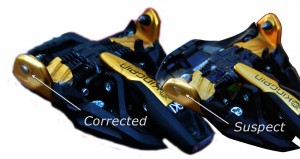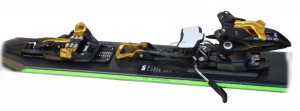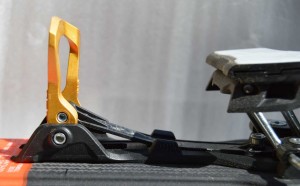The Pin Fix
Not sure you have the upgraded Kingpin toe? It’s easy to tell. If the pins stick out from the arms they are pressed into, by about 1mm, they are the fixed version. If the back of the pins are roughly flush with the outer surface of the arm, they’ve been reported to come loose, or fall out.
Downhill Chops

Back of the pin sticks out about 1mm? Corrected design.
Back of the pin is flush? Known to become loose, or fall out.
The spring is the source of the retention, but what users really like is sensation that their heel is firmly held down. Traditional tech bindings may hold the heel rigid laterally, but the reality is the heel is suspended and this fact is noticeable, especially for those coming from heavy metal alpine bindings.
Free Heelin’ it
On the downhill side of the equation the extra force required to toggle the heel is also required when you are ready to free the heel. What this means is, don’t expect to be able to press the heel down with a carbon fiber ski pole. It will definitely test the lock of your adjustable flick-lock ski poles. A stout, 16mm non-adjustable aluminum pole will do the trick. A more reliable way out is to simply step on it with alternate feet.
In the odd case where you just want to free the heel to glide XC style across a meadow, the Kingpin is actually a great binding for switching gears without having to fully eject from the binding. Just push the heel down, then kneel forward with your knee to the ski, reach behind your boot and flip the mode switch back to retract the heel. Stand up, step on the plastic prongs to flip the heel so you can engage the climbing posts if you want or need them.
Two potential gotchas may make this transition for a lil’ stride and glide action less than seamless. As mentioned above, you might not be able to open the heel up with your pole, meaning you have to step on it with the opposite foot. Easy enough for the first one, but with a free heel, stepping on the opposite foot will take a bit more coordination, or force you to step out of the first ski. Not the end of the world, but certainly not seamless like flipping a Switchback to tour mode. That’s the most likely case.
Icing Issues
Another potential issue may be ice buildup which prevents the heel unit wanting to even move. If you’re not careful, the thin graphite plate that the heel unit slides with may not have enough stiffness to prevent it bowing up, then folding and cracking — putting you in tour mode, permanently. I’m not saying this is a common issue, but here on the wet coast if there’s an icing issue, we’ll find it, however rare or unlikely. We found it. Just sayin’. It could happen to you in the right/wrong circumstances if you’re not looking for it. You’ve been forewarned.There’s another, unlikely but possible, icing issue. Ice can build up behind the locking tab in such a way that you can’t push the release tab down enough to unlock the toe. Snow packs behind the plastic body and then the act of pushing down is attempting to compress snow already packed into ice. It wouldn’t be too difficult to chip the ice out with a screwdriver or even a ski pole tip – if the binding weren’t attached to your boot when this happens. In other words, keep a Leatherman handy.
Overall
Aside from these potential icing issues, and an overly stiff heel spring, the Kingpin is the binding that many budding backcountry skiers have been looking for. A binding that has tech touring efficiency, with an acceptable weight penalty – and believe me, you barely notice the drag weight – with a solid ski connection when hammering hard slopes in-bounds. It does require a boot that can deliver that sort of performance to be able to truly appreciate what Kingpin allows. Here again, you still have the classic conundrum of balancing downhill with uphill performance, but at least the Kingpin won’t be the weak link in the system. If you’re capable, Kingpin delivers a wide range of performance, in and out of bounds.
Marker
Kingpin 13
MSRP: $650
Weight/pr: 3 lbs. 4 oz (1.46 kg)
Release Value: 6 – 13
Kingpin 10
MSRP: $600
Weight/pr: 3 lbs. 1 oz (1.41 kg)
Release Value: 5 – 10
Related Posts
First Look: Marker’s Kingpin
© 2015



1 comment
REI pulled this from their shelves… and won’t mount this binding. They told me that it has failed the VSSE bench testing numerous times… at first they were doing waivers. But now it is company wide policy… no mounting this binding.